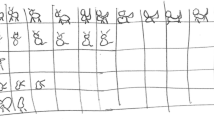Abstract
The National Curriculum programme of study for Science 1 in England and Wales states that pupils should be encouraged to develop investigative skills and understanding of science through activities which “promote the search for patterns in data and the ability to make simple predictions based on findings” (Department of Education and Science, 1991, p. 14). In order to search for patterns children have to first understand the purpose of graphs and the relationship of variables. This paper describes some of the preliminary findings of the Data Handling in Primary Science Project. The majority of primary school children, involved in a data handling project (Rodrigues, 1994), see graphs in science as an end product to be displayed. In addition the children appeared to have a very limited understanding for the type of graph employed being determined by the variable involved. Furthermore whilst some of the children were able to read information from a graph, the language used had a marked effect on cueing the response.
Similar content being viewed by others
References
Austin, R., Holding, B., Bell, J. & Daniels, S. (1989).Assessment matters No. 7. Patterns and relationships in school science. London: SEAC.
Department of Education and Science (1988).Science at age 11. A review of APU survey findings 1980–84. London: HMSO.
Department of Education and Science (1989).Science at age 13. A review of APU survey findings 1980–84. London: HMSO.
Department of Education and Science (1991).Science in the National curriculum (England and Wales). London: HMSO
Duggan, S., & Gott, R. (1994).Investigative work in the science curriculum. Milton Keynes: Open University Press.
Foulds, K., Gott, R., & Feasey, R. (1992).Investigative work in science — A report commissioned by the National Curriculum Council. University of Durham, School of Education.
Gray, C., Rodrigues, S.G.A., Simpson, L., & Sowden, C. (1994).Primary science; Data handling activities: Using graphs, tables and sensors. School of Education, University of Durham.
Jackson, D. F., Edwards, B. J., & Berger, C. F. (1993). Teaching the design and interpretation of graphs through computer aided graphical data analysis.Journal of Research in Science Teaching, 30(5), 483–501.
Phipps, R. (1994). Data handling in scientific investigations in the primary school; some findings and implications of a research project.Education 3–13, 22(2), 26–33.
Rodrigues, S.G.A. (1994).Data handling in primary science project. Working paper 3. Exploration of Science Team, School of Education, University of Durham.
School Curriculum and Assessment Authority (1994, May).Science in the National Curriculum. Draft Proposals. London: HMSO.
Author information
Authors and Affiliations
Additional information
Specializations: use of information technology in primary science, chemistry curriculum development.
Rights and permissions
About this article
Cite this article
Rodrigues, S. Data handling in the primary classroom: Children's perception of the purpose of graphs. Research in Science Education 24, 280–286 (1994). https://doi.org/10.1007/BF02356354
Issue Date:
DOI: https://doi.org/10.1007/BF02356354




